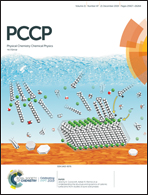The axial/equatorial conformational landscape and intramolecular dispersion: new insights from the rotational spectra of monoterpenoids†
Abstract
Intramolecular non-covalent interactions determine the conformational preferences of many molecules, and their understanding is relevant for a proper description of molecular structure. Here, by using rotational spectroscopy in combination with quantum chemistry calculations, we show that intramolecular dispersion forces involving a three-carbon substituent influence the relative energies and conformational landscape of the three monoterpenoids carvone, limonene and perillaldehyde. New equatorial and axial conformers have been identified for all three molecules. Comparison of experimental data with ab initio and density functional calculations shows that axial conformers are stabilised by dispersion interactions between the cyclohexene ring and the isopropenyl group of the monoterpenoids, and that an accurate account of these interactions is challenging for theoretical methods. This work demonstrates the potential of rotational spectroscopy for investigating non-covalent interactions and provides critical benchmarks for theory. Our results will inform future investigations of axial/equatorial isomerism and impact understanding of intramolecular dispersion in larger species.



 Please wait while we load your content...
Please wait while we load your content...